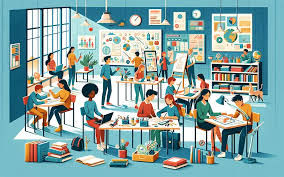Exploring Project Based Learning
- Michael Garrett

- Dec 7, 2024
- 2 min read

In a fast-changing world, the traditional education system faces significant challenges. One promising method becoming popular in education is Project Based Learning (PBL). This method not only sparks interest among learners but also provides them with vital human skills to navigate the complexities of tomorrow's world.
What Is Project Based Learning?
Project Based Learning is a method that encourages learners to acquire and develop further knowledge and understanding of academic subjects by applying these through a hands-on, practical approach to solving real-life problems. This cultivates independence, responsibility, agency, curiosity, creativity, collaboration, communication, teamwork, adaptability, resilience, and a positive growth mindset.
As projects reflect actual challenges and issues, this makes learning more relevant and impactful increasing learner's interest and motivation signifiantly. A 2018 study found that learners engaged in PBL showed an increase in retention rates by up to 50% compared to traditional learning methods. This intrinsic motivation helps create a life long love of learning.
Project Based Learning encourages partnerships with the local community and industries, bridging the gap between education and the real world. This can include inviting guest speakers or working on community projects.
As the purpose and relevance of traditional education continues to be questioned in the face of technological advances and changes in society, Project Based Learning continues to grow, with many leading, forward-focused schools now choosing to adopt this proven methodology for the benefit of their community. For example, High Tech High (HTH) in California is well-known for its project based curriculum that focuses on real-world experiences https://www.hightechhigh.org
How We Do Project Based Learning At Mont21hub.
At Mont21hub, our mixed-age ability groups follow a termly topic that integrates the national curriculum with one of the Sustainable Development Goals to provide true relevance to learning. Our learners follow a predetermined process developed by HTH: Launch, Plan, Create, Critique, Exhibition, and Reflection. Under the guidance of our mentors, our learners develop the knowledge and skills that they will need to solve a problem ending with a final product which they showcase to their peers, staff, visitors and the local community.
What Does This Look Like In Practice?
Within our adaptable learning setting, our learners will arrange the movable tables and chairs according to their preferences. Mixed-age groups will collaborate on various aspects of the project, guided by a chosen team leader. Some learners will conduct online research, while others will write or sketch at tables or work on the writable walls. Additionally, some will be creating artwork, engaging in desktop publishing, or developing physical prototypes. It is a bustling hub of concentrated activity where learners are fully engaged and enjoying their work.
Typical Examples
Our long-term project planning encompasses issues like urban poverty, marine pollution, gender inequality, affordable alternative housing, water scarcity, and the conservation of polar bears, among others.




Comments